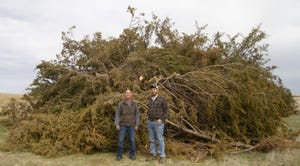Recent equine rabies cases highlight importance of vaccinating
Equine rabies cases in Tennessee and New York serve as reminders that rabies is a real threat to horses, and that the disease can surface at any time
March 12, 2014

Two recent equine rabies cases in Tennessee and one in New York serve as reminders that rabies is a real threat to the lives of horses, and that the disease can surface at any time. While the total number of equine cases is still being tallied for 2013, the number of confirmed equine cases in 2012 reached 47.
“We know there were dozens of cases of equine rabies throughout the country in 2013, including cases from as far east as Vermont, as far south as Texas, as far north as Minnesota and as far west as Colorado,” says Megan Green, DVM, Manager, Large Animal Veterinary Services, Merial. “It is heartbreaking to see a horse suffering from rabies, especially since there are relatively low-cost vaccines widely available. Rabies is completely preventable if the proper steps are taken, but it is 100% fatal if preemptive action is ignored.”
Besides the cases in horses, in the past several years, there have been thousands of incidents of animals with confirmed rabies, 92% of which were in wildlife:
2010 – 6,1556
2011 – 6,0376
2012 – 6,1624
“The numbers of rabid animals in the wild should be concerning to horse owners because all it takes is one bite from an infected animal for a horse to contract the fatal disease,” says Green. “Most horses are kept in areas where it’s impossible to prevent every skunk, fox or raccoon from wandering near enough to come into contact with the horse.”
The onset of rabies is marked by variable clinical signs, which may include aggressive behavior, colic, lack of coordination, hyperexcitability, depression, convulsions or paralysis. The incubation period can take anywhere from two weeks up to 15 months, but once clinical signs appear, death can occur in less than one day.
Because there is no way to diagnose rabies in live animals, horse owners and the treating veterinarians who suspect rabies face the gut-wrenching task of sending the horse’s brain to a diagnostic laboratory where it is examined for the presence of lesions that are characteristic with rabies.
“As spring approaches and horse owners start thinking about vaccinating, they need to keep in mind the risk of exposing their horses to rabies,” says Green. “Horse owners invest significant time and resources into their horses and consider them to be part of the family. The minimal cost to vaccinate is worth so much more in peace of mind knowing a horse is protected from a tragic and preventable death.”
While the best way to prevent equine diseases like rabies is to vaccinate, horse owners can also take advantage of the free Outbreak-Alert program created by Merial. This tool is available to horse owners and veterinarians to help evaluate the risk of diseases such as rabies in their area or areas to which they might be traveling.
The program includes a website with maps indicating the presence of confirmed cases in all species, including the carriers of rabies, West Nile virus, Eastern Equine Encephalitis, Western Equine Encephalitis, influenza, Potomac horse fever and Equine Herpes Virus. Free, printable information about each of the diseases, their clinical signs and treatments is also available on the site.
Horse owners and veterinarians can also sign up for free text or email alerts, which are sent when diseases are identified within a certain radius of their geographic location.
You May Also Like
.png?width=300&auto=webp&quality=80&disable=upscale)


